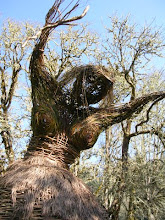40 years ago I was deeply involved in environmental action programs. In fact, my then-spouse was a student at the University or Oregon in the Honors program, part of which included an optional program called “Search.” Each student in Search prepared his or her own topic and, with the supervision of a faculty advisor, outlined a curriculum or project to satisfy academic requirements.
So was born a class titled “Can Man Survive?” Since the catalog for the term had already been issued, my husband (Zed) and his advisor (John) and I sat around our dining room table and made paper signs by hand. We hung these all over campus (an environmental irony I suppose) and planned for 30 students.
We were not far into registration day when one of the registrars called and said that the class had been filled – could it be enlarged? I checked and the answer was, “sure.” So larger room was assigned (150 capacity) but in a couple of hours there was another call. At that point the decision was, “leave it open.” Larger and larger rooms were assigned, until finally the only option was the basketball court. 4200 students signed up, and since the townfolk were also invited, 6300 people attended the first class. It made the Wall Street journal and CBS news.
For some people, it was the first time the word “ecology” entered their vocabulary. The idea of the class was for people to form “action groups” on a matter they felt strongly about, and to devise some methods for dealing with problems. Some opted merely to do research and write reports. Others dove into projects such as cleaning up our local rivers, saving a piece of virgin old growth forest from logging, creating a food co-op and a low-income medical clinic, and many others. Leading experts in various fields from education to environmental issues came to speak. A great deal more happened but my purpose in relating all this is that when we spoke of the loss of family farms, the environmental impact on food supplies from changing climate, drugs in feed, pesticides in produce, and the need to take action - many people blithely replied, “oh, whatever happens the scientists will fix it,” and “there will always be fish in the ocean.” As you know, neither has come to pass. Only now – 40 years later – are some of these issues being taken seriously. And clearly the fish have declined disastrously. When I was a child halibut was one of the cheapest foods you could buy. The last time I looked at it in the market, it was $22.99 a pound.
I didn’t make a typo there. That date really is 1871. The book was published c. 1885. (The book appears to be missing a title page, and the few online listings indicate 1884 and 1885, while the only WorldCat listings are for 1885.) It deals with the construction, outfitting, and voyage of a specially-built steamship for the purpose of studying the fish populations, with many wonderful fold-out plates.
But the book itself raises some questions... It has been recased in a library binding with Smithsonian endpapers and paste-downs, so at least they did this part of the repairs. My curiosity resides with some additional repairs, which seem very amateurish. So I’m wondering whether the Smithsonian could have been so fumble-handed as to perpetrate these atrocities and what the materials used might be. I know for a fact that this book was purchased directly from the Smithsonian when they were deacquisitioning, so perhaps they acquired the book already well used (which seems rather strange) and these repairs were done prior to their ownership.
The folding frontis is reinforced on the back with some kind of laminated or glued plasticky stuff (like cellophane tape, only it apparently came in a sheet.) There is strip of similar material down the front of the fold. Some of that has come loose and it obviously has discolored the paper badly. (The “half-title,” page, which is more like a subtitle or section title, has a reinforcing tape strip on the fore edge, but it appears to be more recent, and different. More like Magic Mending tape, and although yellowed, it seems not to have discolored the paper in the same way as the other stuff.) Man, somebody has really gummed up this rather valuable book!
However, the real question is: does anyone recognize this laminate type material? It doesn’t seem possible that it could be removed without further damage to the already fragile paper, nor could the effects of the adhesive stain be reversed. So I guess I’m just curious as to whether this is something that the Smithsonian would have done, and what this odd material might be.
(Inquiries welcome about purchase of this volume, if anyone is interested.)








